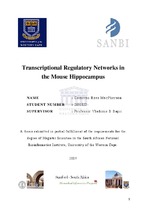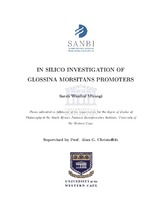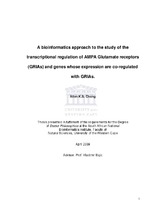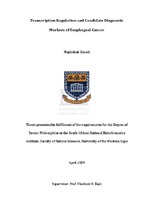Transcriptional regulatory networks in the mouse hippocampus
Abstract
Neurological diseases are socially disabling and often mortal. To efficiently combat these diseases, a deep understanding of involved cellular processes, gene functions and anatomy is required. However, differential regulation of genes across anatomy is not sufficiently well understood. This study utilized large-scale gene expression data to define the regulatory networks of genes expressing in the hippocampus
to which multiple disease pathologies may be associated. Specific aims were: ident i fy key regulatory transcription factors (TFs) responsible for observed gene expression patterns, reconstruct transcription regulatory
networks, and prioritize likely TFs responsible for anatomically
restricted gene expression. Most of the analysis was restricted to the CA3 sub-region of Ammon’s horn within the hippocampus. We identified 155 core genes expressing throughout the CA3 sub-region and predicted corresponding TF binding site (TFBS) distributions. Our analysis shows plausible transcription regulatory networks for twelve
clusters of co-expressed genes. We demonstrate the validity of the predictions by re-clustering genes based on TFBS distributions and found that genes tend to be correctly assigned to groups of previously identified co-expressing genes with sensitivity of 67.74% and positive
predictive value of 100%. Taken together, this study represents one of the first to merge anatomical architecture, expression profiles and transcription regulatory potential on such a large scale in hippocampal sub-anatomy.
Collections
Related items
Showing items related by title, author, creator and subject.
-
In silico investigation of glossina morsitans promoters
Mwangi, Sarah Wambui (University of the Western Cape, 2013)Tsetse flies (Glossina spp) are the biological vectors for Trypanosomes, the causative magents of Human African Trypanosomiasis (HAT). HAT is a debilitating disease that continues to present a major public health problem ... -
A bioinformatics approach to the study of the transcriptional regulation of AMPA glutamate receptors (GRIAs) and genes whose expression are co-regulated with GRIAs
Chong, Allen K.S. (2009)It was postulated that each gene has three main sets of transcriptional elements: one which is gene-specific, one which is family-specific, and a third which is tissue-specific.The starting hypothesis for this project had ... -
Transcription regulation and candidate diagnostic markers of esophageal cancer
Essack, Magbubah (University of the Western Cape, 2009)Esophageal cancer (EC) ranks among the ten most frequent cancers worldwide. Mortality rates associated with EC are very similar to the incidence rates due to the relatively late stage of diagnosis and the poor efficacy of ...




